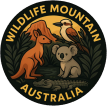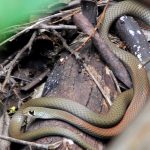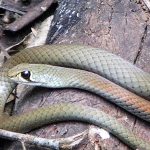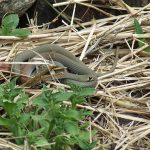YELLOW-FACED WHIPSNAKE
Yellow-faced Whip Snake
The yellow-faced whip snake, scientifically known as Demansia psammophis, is a slender and agile reptile endemic to Australia. Recognised for its distinctive facial markings and swift movements, this species plays a significant role in the ecosystems it inhabits.
Physical Characteristics
Size: Typically measures around 80 cm in length, with some individuals reaching up to 1 metre.
Colouration: Exhibits a pale grey to olive-green dorsal surface, often with a reddish or copper tinge along the anterior third of its body. The underbelly is grey-green to yellowish.
Distinctive Markings: Features a pale ring around each eye, accompanied by a dark, comma-shaped marking curving back below the eye. A dark bar with pale edges runs across the front of the snout from nostril to nostril.
Habitat and Distribution
Range: Found throughout most of Australia, including Queensland, New South Wales, South Australia, Victoria, and Western Australia. It is absent from Tasmania and the far northern regions of the continent.
Preferred Habitats: Inhabits a variety of environments, including open forests, woodlands, grasslands, and suburban areas. They are often found under rocks, logs, and debris, or actively foraging for lizards through leaf litter during warmer weather.
Behaviour and Diet
Activity: Diurnal and fast-moving, with excellent vision aiding in the capture of prey.
Diet: Primarily feeds on small diurnal lizards, such as skinks, and may also consume frogs and lizard eggs.
Venom and Interaction with Humans
- Venom: Mildly venomous; bites can cause localised pain and swelling. While not considered dangerous to humans, medical attention is recommended following a bite.
Reproduction
- Egg Laying: Oviparous, laying clutches of 5–20 eggs. Eggs are typically laid in deep soil or rock crevices.
Conservation Status
- IUCN Red List: Classified as “Least Concern,” indicating a stable population across its range.
Interesting Facts
Identification: Often mistaken for the eastern brown snake due to similar coloration; however, the yellow-faced whip snake is generally smaller and has distinctive facial markings.
Human Interaction: Frequently encountered in suburban areas, especially in regions like Brisbane and the Gold Coast, where they may enter homes during active foraging efforts. (southeastsnakecatcher.com.au)
The yellow-faced whip snake exemplifies the adaptability and resilience of Australian wildlife, thriving in diverse habitats and contributing to the balance of local ecosystems.



